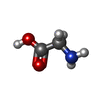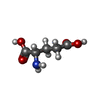[English] 日本語
 Yorodumi
Yorodumi- PDB-5iou: Cryo-EM structure of GluN1/GluN2B NMDA receptor in the glutamate/... -
+ Open data
Open data
- Basic information
Basic information
| Entry | Database: PDB / ID: 5iou | ||||||
|---|---|---|---|---|---|---|---|
| Title | Cryo-EM structure of GluN1/GluN2B NMDA receptor in the glutamate/glycine-bound conformation | ||||||
 Components Components |
| ||||||
 Keywords Keywords | SIGNALING PROTEIN / ligand-gated ion channel / synaptic transmission | ||||||
| Function / homology |  Function and homology information Function and homology informationNMDA glutamate receptor activity / NMDA selective glutamate receptor complex / ligand-gated sodium channel activity / response to zinc ion / response to magnesium ion / glutamate-gated calcium ion channel activity / ionotropic glutamate receptor signaling pathway / sodium ion transmembrane transport / regulation of membrane potential / excitatory postsynaptic potential ...NMDA glutamate receptor activity / NMDA selective glutamate receptor complex / ligand-gated sodium channel activity / response to zinc ion / response to magnesium ion / glutamate-gated calcium ion channel activity / ionotropic glutamate receptor signaling pathway / sodium ion transmembrane transport / regulation of membrane potential / excitatory postsynaptic potential / transmitter-gated monoatomic ion channel activity involved in regulation of postsynaptic membrane potential / synaptic transmission, glutamatergic / postsynaptic density membrane / regulation of synaptic plasticity / calcium ion transmembrane transport / long-term synaptic potentiation / late endosome / signaling receptor activity / chemical synaptic transmission / postsynaptic membrane / lysosome / neuron projection / synapse / metal ion binding / plasma membrane Similarity search - Function | ||||||
| Biological species | |||||||
| Method | ELECTRON MICROSCOPY / single particle reconstruction / cryo EM / Resolution: 7 Å | ||||||
 Authors Authors | Zhu, S. / Stein, A.R. / Yoshioka, C. / Lee, C.H. / Goehring, A. / Mchaourab, S.H. / Gouaux, E. | ||||||
 Citation Citation |  Journal: Cell / Year: 2016 Journal: Cell / Year: 2016Title: Mechanism of NMDA Receptor Inhibition and Activation. Authors: Shujia Zhu / Richard A Stein / Craig Yoshioka / Chia-Hsueh Lee / April Goehring / Hassane S Mchaourab / Eric Gouaux /  Abstract: N-methyl-D-aspartate receptors (NMDARs) are glutamate-gated, calcium-permeable ion channels that mediate synaptic transmission and underpin learning and memory. NMDAR dysfunction is directly ...N-methyl-D-aspartate receptors (NMDARs) are glutamate-gated, calcium-permeable ion channels that mediate synaptic transmission and underpin learning and memory. NMDAR dysfunction is directly implicated in diseases ranging from seizure to ischemia. Despite its fundamental importance, little is known about how the NMDAR transitions between inactive and active states and how small molecules inhibit or activate ion channel gating. Here, we report electron cryo-microscopy structures of the GluN1-GluN2B NMDA receptor in an ensemble of competitive antagonist-bound states, an agonist-bound form, and a state bound with agonists and the allosteric inhibitor Ro25-6981. Together with double electron-electron resonance experiments, we show how competitive antagonists rupture the ligand binding domain (LBD) gating "ring," how agonists retain the ring in a dimer-of-dimers configuration, and how allosteric inhibitors, acting within the amino terminal domain, further stabilize the LBD layer. These studies illuminate how the LBD gating ring is fundamental to signal transduction and gating in NMDARs. | ||||||
| History |
|
- Structure visualization
Structure visualization
| Movie |
 Movie viewer Movie viewer |
|---|---|
| Structure viewer | Molecule:  Molmil Molmil Jmol/JSmol Jmol/JSmol |
- Downloads & links
Downloads & links
- Download
Download
| PDBx/mmCIF format |  5iou.cif.gz 5iou.cif.gz | 440.2 KB | Display |  PDBx/mmCIF format PDBx/mmCIF format |
|---|---|---|---|---|
| PDB format |  pdb5iou.ent.gz pdb5iou.ent.gz | 288.3 KB | Display |  PDB format PDB format |
| PDBx/mmJSON format |  5iou.json.gz 5iou.json.gz | Tree view |  PDBx/mmJSON format PDBx/mmJSON format | |
| Others |  Other downloads Other downloads |
-Validation report
| Summary document |  5iou_validation.pdf.gz 5iou_validation.pdf.gz | 922.7 KB | Display |  wwPDB validaton report wwPDB validaton report |
|---|---|---|---|---|
| Full document |  5iou_full_validation.pdf.gz 5iou_full_validation.pdf.gz | 938.5 KB | Display | |
| Data in XML |  5iou_validation.xml.gz 5iou_validation.xml.gz | 67.7 KB | Display | |
| Data in CIF |  5iou_validation.cif.gz 5iou_validation.cif.gz | 109.7 KB | Display | |
| Arichive directory |  https://data.pdbj.org/pub/pdb/validation_reports/io/5iou https://data.pdbj.org/pub/pdb/validation_reports/io/5iou ftp://data.pdbj.org/pub/pdb/validation_reports/io/5iou ftp://data.pdbj.org/pub/pdb/validation_reports/io/5iou | HTTPS FTP |
-Related structure data
| Related structure data |  8097MC  8098C  8101C  8102C  8103C  8104C  8105C  8106C  5iovC  5ipqC  5iprC  5ipsC  5iptC  5ipuC  5ipvC M: map data used to model this data C: citing same article ( |
|---|---|
| Similar structure data |
- Links
Links
- Assembly
Assembly
| Deposited unit | 
|
|---|---|
| 1 |
|
- Components
Components
| #1: Protein | Mass: 92651.234 Da / Num. of mol.: 2 Mutation: K51F, R52F, N300Q, N350Q, N368D, N440D, N469D, K493A, K494A, E495A, G610R, I617L, D656R, N769E Source method: isolated from a genetically manipulated source Source: (gene. exp.)  Homo sapiens (human) / References: UniProt: C0KD18, UniProt: A0A1L8F5J9*PLUS Homo sapiens (human) / References: UniProt: C0KD18, UniProt: A0A1L8F5J9*PLUS#2: Protein | Mass: 93234.742 Da / Num. of mol.: 2 Mutation: M20S, G21R, C22A, A64E, N69Q, N343D, T490V, V615L, E654R, E655R Source method: isolated from a genetically manipulated source Source: (gene. exp.)  Homo sapiens (human) / References: UniProt: A7XY94 Homo sapiens (human) / References: UniProt: A7XY94#3: Chemical | #4: Chemical | |
|---|
-Experimental details
-Experiment
| Experiment | Method: ELECTRON MICROSCOPY |
|---|---|
| EM experiment | Aggregation state: PARTICLE / 3D reconstruction method: single particle reconstruction |
- Sample preparation
Sample preparation
| Component | Name: GluN1-GluN2B NMDA receptor / Type: ORGANELLE OR CELLULAR COMPONENT / Entity ID: #1-#2 / Source: RECOMBINANT |
|---|---|
| Source (natural) | Organism: |
| Source (recombinant) | Organism:  Homo sapiens (human) / Plasmid: unknown Homo sapiens (human) / Plasmid: unknown |
| Buffer solution | pH: 6.5 |
| Specimen | Embedding applied: NO / Shadowing applied: NO / Staining applied: NO / Vitrification applied: YES |
| Vitrification | Cryogen name: ETHANE |
- Electron microscopy imaging
Electron microscopy imaging
| Experimental equipment |  Model: Titan Krios / Image courtesy: FEI Company |
|---|---|
| Microscopy | Model: FEI TITAN KRIOS |
| Electron gun | Electron source:  FIELD EMISSION GUN / Accelerating voltage: 300 kV / Illumination mode: OTHER FIELD EMISSION GUN / Accelerating voltage: 300 kV / Illumination mode: OTHER |
| Electron lens | Mode: BRIGHT FIELD / Nominal defocus max: 4000 nm / Nominal defocus min: 2500 nm / Cs: 2 mm |
| Specimen holder | Cryogen: NITROGEN |
| Image recording | Average exposure time: 8 sec. / Electron dose: 8.7 e/Å2 / Detector mode: COUNTING / Film or detector model: GATAN K2 SUMMIT (4k x 4k) |
| Image scans | Movie frames/image: 40 |
- Processing
Processing
| EM software | Name: RELION / Version: 1.3 / Category: 3D reconstruction |
|---|---|
| CTF correction | Type: PHASE FLIPPING AND AMPLITUDE CORRECTION |
| Particle selection | Num. of particles selected: 185009 |
| Symmetry | Point symmetry: C1 (asymmetric) |
| 3D reconstruction | Resolution: 7 Å / Resolution method: FSC 0.143 CUT-OFF / Num. of particles: 116968 / Symmetry type: POINT |
| Refinement | Highest resolution: 7 Å |
 Movie
Movie Controller
Controller





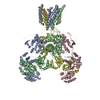

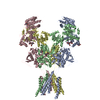

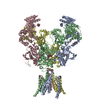
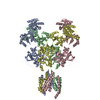
 PDBj
PDBj



